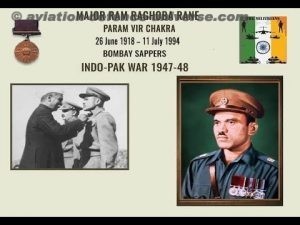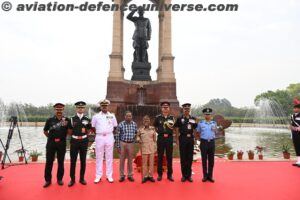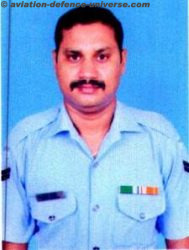 New Delhi. Param Vir Chakra. Major Rama Raghoba Rane, PVC (26 June 1918 – 11 July 1994) was an officer in the Indian Army. He was the first living recipient of the Param Vir Chakra, India’s highest military decoration. Born in 1918, Rane served in the British Indian Army during the Second World War.
New Delhi. Param Vir Chakra. Major Rama Raghoba Rane, PVC (26 June 1918 – 11 July 1994) was an officer in the Indian Army. He was the first living recipient of the Param Vir Chakra, India’s highest military decoration. Born in 1918, Rane served in the British Indian Army during the Second World War.
Rama Raghoba Rane was born on 26 June 1918 in the village of Haveri in the Karwar district of Karnataka. He was the son of Raghoba. P. Rane, a police constable from Chendia village of North Kanada district in Karnataka.Rane’s early education, mostly in district school, was chaotic due to his father’s frequent transfers. In 1930, he became influenced by the Non-Cooperation Movement, which agitated for Indian independence from Great Britain. His involvement with the movement alarmed his father, who moved the family back to their ancestral village at Chendia.
At the age of 22, Rane decided to join the British Indian Army, while the Second World War was in full swing. On 10 July 1940, Rane enlisted in the Bombay Engineer Regiment, and passed out as the “Best Recruit”, awarded the Commandant’s Cane. Subsequently, he was promoted to Naik (corporal).
After his training, Rane was posted to the 28th Field Company, an engineering unit of the 26th Infantry Division which, at the time, was fighting the Japanese in Burma. As his division retreated from the Japanese after the failed Arakan Campaign, he, along with his two sections, was hand-picked by his company commander to stay back behind at Buthidaung to destroy key assets and then be evacuated by the Royal Indian Navy. Though the objective was soon achieved, the expected pickup did not happen. This forced Rane and his men to cross a river that was patrolled by the Japanese to reach their lines. Rane, along with his two sections, expertly evaded the Japanese troops, and joined the 26th Infantry Division at Bahri. For his actions, he was promoted to havaldar (sergeant).
After the war, Rane remained in the military. In 1947, following his country’s independence, he transferred to the Indian Army and achieved the rank of jemadar (now the rank of naib subedar, equivalent to a warrant officer). For his persistence and leadership qualities, Rane was selected for a short-service commission prior to the partition. He was formally commissioned in the Corps of Engineers on 15 December 1947 as a second lieutenant.
On 18 March 1948, Jhangar, lost in December 1947 to the Pakistanis, was recaptured by troops of the Indian Army, which then started to move towards Rajauri from Naushahra sector. On 8 April 1948, the 4th Dogra Battalion advanced to Rajauri. During the advance, the battalion attacked and captured the Barwali ridge, eleven kilometers to the north of Naushahra. The battalion’s advance beyond Barwali was obstructed by the increasing number of roadblocks and minefields. Supporting tanks were also unable to cross the obstacles.
Rane, in command of a section of the 37th Assault Field Company, attached to the 4th Dogra Battalion, was sent forward to help clear a path for the battalion. As Rane and his team started clearing a minefield, mortar fire from the Pakistanis killed two sappers and wounded five others, including Rane. Despite this, by the evening of 8 April, Rane and his surviving men cleared the minefield which enabled the supporting tanks to move forward. A safe lane still had to be prepared for the tanks as the road ahead was still dangerous; the Pakistani forces had yet to be cleared from the area. This lane was created by Rane through the night. The next day, his section worked for twelve continuous hours to clear mines and roadblocks. As the road was still too difficult to deal with, he made a diversion for the battalion to forward. Rane continued this work despite ongoing artillery and mortar fire from the Pakistanis.
On 10 April, Rane got up early and resumed work on an obstacle that had not been cleared the previous night. Within a span of two hours, he cleared the roadblock of five large pine trees in the midst of mines and machine-gun fire. This allowed the 4th Dogra Battalion to advance another thirteen kilometers until it encountered another major roadblock. The Pakistani forces were situated on the adjoining hills and able to fire on all approaches to the block, making its destruction problematic. Rane drove a tank to the roadblock and took cover behind the tank while blasting open the roadblock with mines, opening the road before the end of the night.
The next day, Rane worked for another seventeen hours to open the road to Chingas, which lay half-way between Rajauri and Naushahra on an old Mughal route, and beyond. During the period from 8 to 11 April, he had made a significant contribution in the Indian advance to Rajauri. His work not only cost the Pakistani forces about 500 dead and many more wounded, but also saved many civilians in the area from Chingas and Rajauri.
Gazette Notification: 5 Pres/50, 21-6-50
Operation: 1948 Polo – Hyderabad
Date of Award: 08 Apr 1948
Citation:
On 8 April 1948, 2nd Lieutenant Rama Raghoba Rane was ordered to be in charge of the mine and roadblock clearing party at mile 26 on the Naushera to Rajauri road which passes through very hilly country. At 1100 hrs on that date near Nadpur South just as 2nd Lieutenant Rane and his party were waiting near the tanks to start the work of clearing the mines ahead, the enemy started heavy mortaring of the area, with the result that two men of the party were killed and five, including himself, wounded. He at once reorganised his party and started clearing the passage for the tanks to go on to their position. Throughout that day he was near the tanks under heavy enemy machine gun and mortar fire. After the capture of Banvali Ridge at about 1630 hrs, although knowing that the enemy had not been completely cleared of the area, 2nd Lieutenant Rane took his party ahead and started making a diversion for the tanks to proceed. He worked on till 2200 hrs that night in full view of the enemy and under heavy machine gun fire.
On 9 April he again started work at 0600 hrs and worked on till 1500 hrs when the diversion was ready for the tanks to proceed. As the armoured column advanced he got into the leading carrier and proceeded ahead. After advancing about half a mile he came across a roadblock of pine trees. He at once dismounted and blasted the trees away. The advance continued. Another 300 yards and the same story was repeated. By this time it was getting onto 1700 hrs. The road was curving round the hills like a snake. The next roadblock was a blasted-away culvert. 2nd Lieutenant Rane again got on with the job. Before he could start the work, the enemy opened up with their machine guns but with superb courage and leadership he made a diversion and the column proceeded ahead. The roadblocks were becoming numerous but he blasted his way through. It was now 1815 hrs. The light was fading fast. The carrier came across a formidable roadblock of five big pine trees surrounded by mines, and covered by machine gun fire. He started removing the mines and was determined to clear the block but the armoured column commander appreciating the situation got the column into a harbour area.
On 10 April at 0445 hrs, 2nd Lieutenant Rane again started work on the roadblock in spite of enemy machine gunfire with the support of one troop of tanks. With sheer willpower he cleared this roadblock by 0630 hrs. The next thousand yards of the road was a mass of roadblocks and blasted embankments. That was not all. The enemy had the whole area covered with machine gun fire but with superhuman efforts, in spite of having been wounded, with cool courage, exemplary leadership and complete disregard for personal life, he cleared the road by 1030 hrs. The armoured column proceeded ahead. The tanks reached Chingas by 1400 hrs. 2nd Lieutenant Rane continued clearing the road for the administrative column. ‘The tanks reached Chingas by 1400 hrs. 2nd Lieutenant Rane, appreciating that the opening of the road was most vital, continued working without rest or food till 2100 hrs that night.
On 11 April, he again started work at 0600 hrs and opened the road to Chingas by 1100 hrs. He worked on that night till 2200 hrs clearing the way ahead. The supreme courage displayed by 2nd Lieutenant Rane in carrying out the most dangerous task of clearing mines and road blocks continuously for four days, whilst under incessant enemy fire, with total disregard for his life had enabled our tanks to reach Chingas. His sustained gallant effort, whilst constantly facing death, was in the finest traditions of the Indian Army.


























































































































